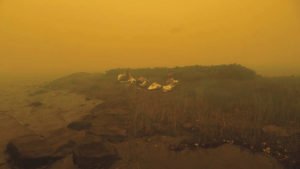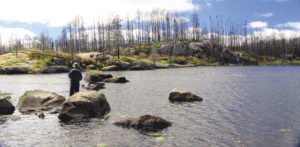Ely—A video posted online in late November of 2016 details how close Minnesota’s Pagami Creek Fire came to taking the lives of six U.S. Forest Service employees.
The video comes to the surface five years after the massive fire was put to rest. First detected on Aug. 18, 2011, the Pagami Creek Fire eventually raged across approximately 93,000 acres of land in and around the Boundary Waters Canoe Area Wilderness (BWCAW).
Nancy Moundalexis, one of the Forest Service employees interviewed in the video, told Northern Wilds that safety of all parties was the constant, primary objective on Sept. 12.
“I just feel extremely relieved that no public or Forest Service employees were seriously injured in the fire,” she said.
According to the DNR, the Pagami Creek Fire was the seventh-largest fire in Minnesota history and the largest inside state lines in nearly 100 years. The powerful blaze vaporized trees and resulted in a towering 35,000-foot plume that created its own weather system. Smoke from the fire drifted as far as Chicago.
A series of reports, including the extensive document titled Pagami Creek Fire Entrapments—Facilitated Learning Analysis, show that the Forest Service severely underestimated the blossoming power of the Pagami Creek Fire during a two-week window in late August and early September of 2011. These miscalculations allowed a half-acre burn to grow into a massive firestorm that could be seen from space. Highlighting this underestimation of the fire’s power was a decision over Labor Day weekend to dump 1,700 gallons of jellied gasoline from helicopters onto the fire. According to the public documents, which date back to the year of the fire, the rationale for the ‘burn-over’ using gasoline included concern that conditions were too volatile to put crews on the ground and worsening drought conditions in the region. A burn-over is typically done to create a firebreak, or gap, in the hopes of containing spreading wildfires. In this case, the plan did not work properly.

And while Forest Service fire-management policies were under question immediately after and in the years following the Pagami Creek blaze—including the fact the fire settled in with a price tag of $23 million—the aforementioned video is the first public play-by-play of events as told by the six wilderness rangers whose lives were in danger. The crew of six had to deploy emergency fire shelters as the Pagami Creek blaze approached, a last-resort policy that potentially saved their lives.
Anthony Petrilli works on the design and safety of fire shelters for the U.S. Forest Service. He also recorded the video of the six wilderness rangers as they explained what happened during the fire. The interviews of the six rangers were conducted in 2012 by Petrilli and Lisa Outka-Perkins on Insula Lake, where the narrow escape occurred one year prior.
“They have a one of a kind tale to tell,” Petrilli said of the wilderness rangers interviewed in the project. “It’s a harrowing tale.”
The six fire-qualified wilderness rangers interviewed in the video are Todd Stefanic, Chris Kinney, Nancy Moundalexis, Andrea Lund, Nancy Hernesmaa and Naomi Weckman. They explain in great detail during the 35-minute video what happened as the fire approached on Sept. 12. The climax of the stories comes with the explanation of the crew deploying their fire shelters, which resemble large blankets covered in aluminum foil. Prior to deploying the fire shelters, four of the rangers took refuge on a tiny island on Lake Insula. Two others, Weckman and Hernesmaa, abandoned their canoe and deployed their shelter while floating in Lake Insula, relying on their life jackets to keep them afloat.
As they recall the incident, the six wilderness rangers describe burning embers shooting through the sky like laser beams, almost no visibility due to smoke and a disturbingly dark sky and the sound of the approaching fire being like that of an oncoming train. Weckman and Hernesmaa describe hypothermia setting in while they hid under their fire shelters in the lake. When the fire finally passed and they could emerge from the lake, hail started to pound the women from the sky.
Petrilli is based in Montana at the Forest Service’s Missoula Technology and Development Center. When asked why media attention has focused largely on the size of the fire, what happened to campsites in the BWCAW or on regrowth of the forest rather than the harrowing escape of the six wilderness rangers, Petrilli did not mince words.
“Fire shelters don’t make the news unless they don’t work and people die,” he said. “But when people live, yeah, it’s not going to make the news.”
According to the Forest Service reports and the stories of the six interviewed in what is essentially a short documentary, on Sept. 12 the wilderness rangers were making public contacts to ensure that no recreationists were in the area that had been closed due to safety concerns.
“These folks were wilderness rangers,” Petrilli said. “They’re minimally fire qualified. They are not firefighter experts; they are minimally qualified to no fault of their own. Their job is not to be firefighters. Their job is wilderness rangers and public safety.”

Petrilli made it clear during an interview with Northern Wilds he did not want to comment on the specifics of Forest Service policy regarding fire management of Pagami Creek or any other fire. And the video featuring the six wilderness rangers was created specifically for educational purposes to be used by the federal government and other firefighting agencies.
All told, the Pagami Creek Fire destroyed numerous campsites and rendered many canoe portages and trails unusable and unsafe within the federally-protected wilderness. And yet, just five years later, the burn area remains a popular destination for visitors to the BWCAW.
Despite its immense size, the Pagami Creek Fire caused no serious injuries or human deaths. And for the six Forest Service employees interviewed in the video, the memories of what happened on Sept. 12, remain vivid more than five years later.
“As strange as it may sound, as far as being out on Insula, I still feel awed and humbled by the power and immensity of that fire,” Moundalexis said. “And I will never forget what it was like out there that day.”
The video described in this story can be viewed at: wildfiretoday.com/tag/pagami.


